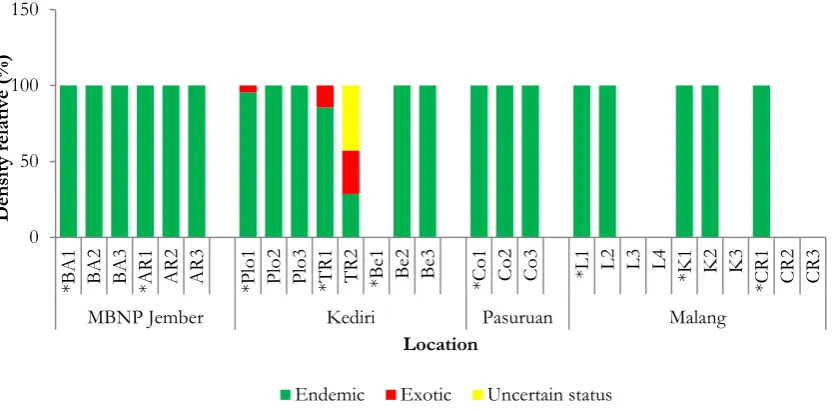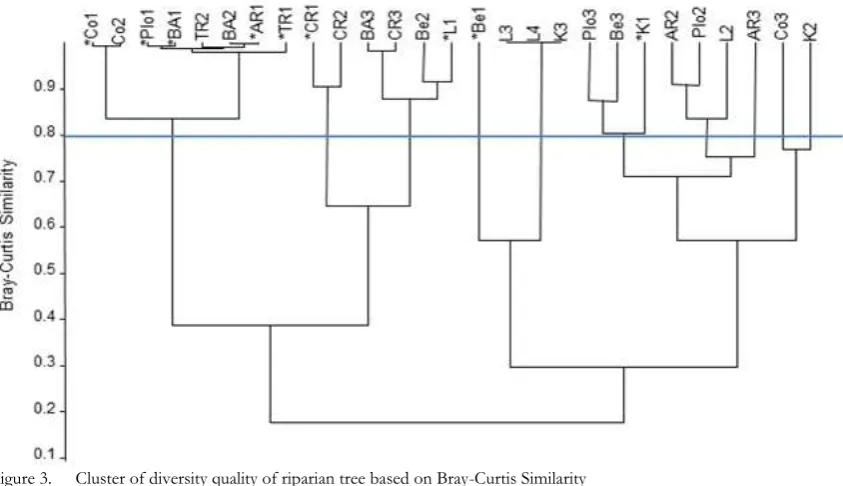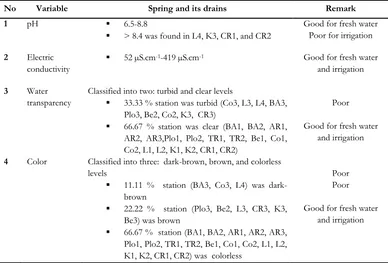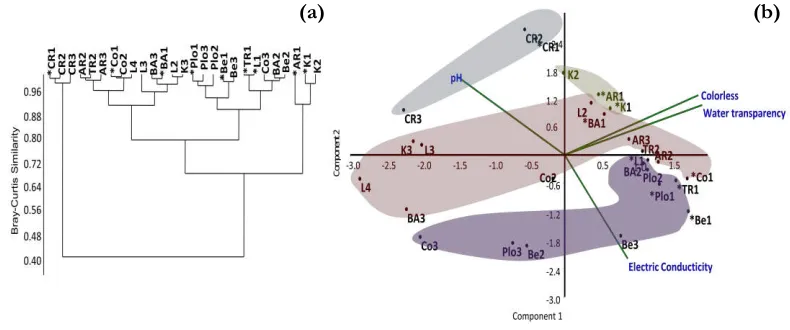Degradation of Riparian Tree Diversity on Spring Fed Drains and Its
Impacts to Water Quality, East Java
Chatarina Gradict Semiun*, Endang Arisoesilaningsih, Catur Retnaningdyah
Biology Department, Faculty of Mathematics and Natural Sciences, Brawijaya University, Malang, Indonesia
ABSTRACT
The research aimed at examining the impacts of degradation of riparian tree diversity toward water quality from some springs to their drains in East Java, Indonesia. This descriptive study was conducted in selected springs and their drains in Jember, Kediri, Pasuruan, and Malang from April 2012 to January 2013. Spring water of Meru Betiri National Park was chosen as a reference site. The quality of riparian tree diversity and the water was sampled on three replications. Data were tabula-ted by statistical analyses using cluster and Spearman correlation. The result showed that there were 69 species belonging to 28 families of riparian tree were found in the springs and their drains. Moraceae was found to be the key family of natural riparian trees, and native trees, except in Kediri, inhabited almost all springs and their drains (92.75 %). All the observed springs were degrading, compared to the natural one in Meru Betiri National Park where trees grew in strata A to E and showed the highest diversity index (H’=3.2). All springs were found to have high quality of water, but the water in their downstream became so turbid, depending on the quality of riparian tree diver-sity grown around the springs. The quality of riparian diverdiver-sity was strongly influenced by land use and human activities such as illegal logging, intensive agriculture, and settlement. There was a posi-tive correlation between riparian tree diversity and water transparency and color; yet, there was a negative correlation with pH of the water. Low pH, high water transparency and colorless water were found in stations where we found rich tree species, high diversity index, wide and stratified riparian trees.
Keywords: diversity quality, riparian tree, spring water , water quality
INTRODUCTION
Generally, the existing riparian vegetation consists of areas is dominated by native plants such as trees, shrubs, herbs, and grasses [1]. The trees are usually disturbed, especially by human activities. Stream bank vegetation reduces the rate of erosion. Root systems of trees or shrubs pro-tect stream banks from erosion by reinforcing and increasing cohesion of the soil, and by providing protective service matting. Trees use water from the banks, and increase the drainage of the soils that help reducing bank failure due to heavy saturated soil. Riparian vegetation can also play an important role in trapping sediment and its attached pollutants and nutrients before they reach
*
Corresponding author: Chatarina Gradict Semiun
Biology Department, Faculty of Mathematics and Natural Sciences, Brawijaya University, Jalan Veteran, Malang, Indonesia 65145
E-mail: [email protected]
the drains [2].
The existence of natural riparian vegetation is a determinant factor for high or low water quality of water body especially in springs. A spring is an underground source of water emerging naturally on the surface of the ground; may come in a form of intermittent or perennial flow and be dis-charged at specific locations on earth; and they vary dramatically as to the types of water they dis-charge [3, 4]. Because of human activities, the quality of spring water has been decreasing [5]. Inappropriate land uses, such as illegal logging, agriculture on sloping land, settlement around the water body, grazing in poor land, etc, can enda-nger the quality of riparian vegetation [6, 7]. Land uses, deforestation, the level of nutrients and pes-ticide application affect the quality of the ground-water [8].
In addition, the water from these springs is the main source for organic farming; thus, we need to protect its quality, including the quality of water in canals. The research, therefore, aims at examining the impacts of degradation of riparian tree diver-sity toward water quality on some springs and their drains in East Java.
MATERIALS AND METHODS
Almost all the springs observed during the field research were surrounded by riparian vegetation, and almost all of them had been converted, or degraded, because of human acti-vities. The riparian tree vegetation at forestry zones of Blok Aren, in Sanenrejo village, was still natural or free from bad human activities. In the field, the researchers observed the habi-tat of riparian tree vegehabi-tation at the height of less than 1200 m above sea level (asl), areas ca-tegorized as lowland. Meanwhile, the research-ers also observed low mountainous areas, at the height of 1290 m asl, that was in Coban Rondo. Based on the observation, almost all springs have mountain slopes as their borders with the steep of 25-55 ° (47-119 %), while their drains have various borders, ranging from flat, going down to slope, a bit steep, steep, and very steep surfaces.
This descriptive study was conducted on selected springs, by observing three sites for each station including Blok Aren Meru Betiri National Park (MBNP) Jember (as a reference site), Kediri, Pasuruan, and Malang. It was done from April 2012 to January 2013. The observed locations were grouped into 9 groups, each of (CR). The field observation included the obser-vation on the quality of riparian tree diversity and quality of water from the springs up to their drains. The variables for riparian tree di-versity consist of species and total individual, height, diameter, and stratification. The varia-bles for water quality were pH, measured by pH meter, electric conductivity, measured by con-ductivity meter, and visual observation of water transparency and color.
Data were tabulated using Microsoft Excel 2007. A multivariate analysis of cluster and bi-plot were done employing PAST software to determine the profile of riparian tree diversity
(species richness, diversity index, important va-lue index, rate of endemism, and Bray-Curtis si-milarity index) and water quality profile (cluster and bi-plot analysis). Analysis of Spearman cor-relation was used to determine the interaction species richness was found in Plo1 (13 species), and BA1 (12 species). However, riparian trees were not found on spring and irrigation drains such as Be1, L3, L4, K3, CR2, and CR3 (Figure 1a). The commonest family found on springs and their drains was Moraceae family. This is line with the research report by Soejono (2011) [9] stating that Moraceae family found in springs has high variety. Further, Moraceae is a family with 38 genera and 1100 species wide spread mainly in tropical areas [10]. The ripa-rian trees around springs such as BA1, AR1, Plo1, TR1, L1, K1, and CR1 showed high level of diversity compared to the tree vegetation located around drains (Figure 1b). The highest
diversity index was in BA1 (H’=3.2) and BA2 (H’=3.0) caused by their complexity and density
of species richness in each sampling plot. Naturally, the structure of riparian tree vege-tation is composed of various taxa, so it is rare to find a particular species to be dominant. of endemism rate (Figure 2) showed that native trees, except in Kediri (Plo1 and TR2), mostly dominated the tree vegetation on springs and their drains (92.75 %).
Figure 1. Species richness of riparian tree (a) and diversity index of riparian tree (b)
Note: * ) Spring; BA = Blok Aren; AR = Andongrejo; Plo = Plosolor; TR = Tempurejo; Be = Bendo; Co = Cowek; L = Lawang; K = Karangan; CR = Coban Rondo
Figure 2. Endemism of riparian trees grown around of spring and its drain, East Java
Note: * ) Spring; BA = Blok Aren; AR = Andongrejo; Plo = Plosolor; TR = Tempurejo; Be = Bendo; Co = Cowek; L = Lawang; K = Karangan; CR = Coban Rondo
Figure 3. Cluster of diversity quality of riparian tree based on Bray-Curtis Similarity
Note: * ) Spring; BA = Blok Aren; AR = Andongrejo; Plo= Plosolor; TR = Tempurejo; Be = Bendo; Co = Cowek; L = Lawang; K = Karangan; CR = Coban Rondo
Profile of Water Quality
The water quality in springs and their drains illustrated by pH, electric conductivity, water transparency and color were all found to be vari-ous in 27 locations observed during the field re-search. The similarity value (pH) of water in the springs and drains was identified normal, ranging from 6.5-8.8 (Figure 4a). Based on the
research-ers’ examination, the value was found to still ful -fill the standard of water quality according to Indonesian Government Regulation number 82, 2001, concerning on Water Quality Management and Water Pollution Control of Class I to Class IV, which is 6-9. In some locations where drains pass through rice fields coded as L4, K3, and CR2, the quality of water over reached the inter-national quality standard stated by FAO, which is 6.5 to 8.4. High pH above 8.5 is often caused by high concentration of bicarbonate (HCO3-) and
carbonate (CO32-), known as alkalinity. High
car-bonates cause calcium and magnesium ions to form insoluble minerals leaving sodium as the dominant ion in solution. As described in the sodium hazard section, this alkaline water could intensify the impact of high SAR water on acidic soil conditions [13].
The conductivity measurement of springs and their channels showed various results (Figure 4b). The lowest conductivity value was found at CR2, which was 52 µS.cm-1, while the highest
was at Be3, which was 419 µS.cm-1. These values
are categorized as good because they fulfill the conductivity standard of fresh water and irriga-tion. The higher the EC, the less water is
avai-lable to plants, even though the soil may appear wet [13].
The levels of water transparency in 27 locations were classified into two: turbid and clear levels. Springs and their drains in general showed clear water (66.67 %), which were at BA1, AR1, Plo1, TR1, Be1, L1, K1, and CR1. Meanwhile, turbid water was found on drains of springs. The water transparency was affected by mud, plankton, and water color [14]. Many sediments coming into the body of water caused turbidity. The color of the water in 27 locations was classified into three: dark-brown, brown, and colorless. Springs and their drains had no color (66.67 %). The drains themselves were differen-tiated into dark-brown (11.11 %) located at BA3, Co3, and L4 and brown (22.22 %) at Plo3, Be2, Be3, L3, CR3, and K3. The brown one was generally formed by sediment brought by stream causing the water transparency to decrease, while turbidity in-creased [15]. Bi-plot analysis (Figure 5b) showed that water quality profile of the 27 locations were composed by four groups (sup-ported by hierarchical cluster analysis in PAST). CR was characterized by high pH, otherwise Plo, Be, TR1, L1, and Co3 were characterized by high electric con-ductivity.
Analysis of spearman correlation
Figure 4. Specific variation of water pH (a) and electric conductivity (b) of springs and their drains
Note: *) Spring; EC = Electric Conductivity; BA = Blok Aren; AR = Andongrejo; Plo = Plosolor; TR = Tempurejo; Be = Bendo; Co = Cowek; L = Lawang; K = Karangan; CR = Coban Rondo
Table 1. Profile of water quality in comparison with quality standard of water for irrigation
No Variable Spring and its drains Remark
1 pH 6.5-8.8
Classified into two: turbid and clear levels
33.33 % station was turbid (Co3, L3, L4, BA3,
4 Color Classified into three: dark-brown, brown, and colorless levels Lawang; K = Karangan; CR = Coban Rondo
Figure 5. Grouping of water quality using Bray Curtis Similarity index (a) and bi-plot (b)
Note: *) Spring; BA = Blok Aren; AR = Andongrejo; Plo = Plosolor; TR = Tempurejo; Be = Bendo; Co = Cowek; L = Lawang; K = Karangan; CR = Coban Rondo
high richness of species, diversity index, width, and stratified riparian tree (Table 2). It shows that the riparian tree conserved on border spring or on its drains indicates high water quality com-pared to that at degraded border. The height of turbidity could degrade spring water quality. The riparian vegetation capable to prevent body of water from sediments as the result of the de-crease of turbidity; while the water transparency increases [16]. The riparian tree protects the qua-lity of water by means of its strong roots that can prevent land slide and erosion, filter of soluble nitrogen, phosphor, and various pollutants mo-ving along slope [17]. On the otherhand, low pH, higher water transparency and colorless water were found in stations where the researchers re-corded high richness of riparian species, diversity index, width, and stratified tree. It is suspicious that the decrease in pH was related to detriti-vores activity by using litter of macrophyte due to respiration process [18].
CONCLUSION
Degradation of riparian trees has brought great impacts on water quality, which was increa-sing water turbidity. There was a positive corre-lation between riparian tree diversity and water transparency and color, but it had a negative correlation with water pH. Low pH, high water transparency and colorless water were found in stations having high species richness, diversity index, riparian width, and stratification of trees.
ACKNOWLEDGEMENTS
This research was financed by research Grant I-MHERE and supported by Dr. Endang
Arisoesilaningsih, Biology Department, Brawijaya University. We would like to thank Mr. Budi and Mr. Topan for their helpful assistance at the field for research areas in Meru Betiri National Park.
REFERENCES
1. Natta KA, Sinsin B, van der Maesen L (2002) Riparian forests, a unique but endangered eco-system. Bot. Jahrb. Syst. 124 (1): 55-69.
2. Malik R, Shinwari ZK, Waheed H (2012)
Linkages between spatial variations in riparian vegetation and floristics quality to the environ-mental heterogenity a case study of River Soan and its Associated Streams, Pakistan. Pak. J. Bot. 44: 187-197.
3. Kreye R, Wei M, Reksten D (1996) Defining the source area of water supply springs. Hydrology branch, ministry of environment, lands and parks. British Columbia.
4. Sen S, Mohapatra SK, Satpathy S, Rao G (2010) Characterization of hot water spring source isolated clones of bacteria and their industrial applicability. Int. J. Chem. Res. 2(1): 01-07. 5. Siwek J, Chelmicki W (2004) Geology and land
use related pattern of spring water quality. Case study from the catchments of the Malopolska upland (S. Poland). Geologica acta: Int. J. Earth Sci. 2(2): 167-174.
6. Belsky JA, Matzke A, Uselman S (1999) Survey of
livestock influences on stream and riparian ecosystems in the Western United States. J. Soil Water Conserv. 55: 419-431.
7. Twesigye C, Onywere SM, Getenga ZM,
Mwakalila SS, Nakiranda JK (2011) The Impact of land use activities on vegetation cover and water quality in the Lake Victoria Watershed. J. Open Environt. Eng. 4: 66-77.
8. Sharma U (2001) Effects of farming system type on in situ groundwater recharge and quality in northeast India. Proceedings of a symposium heid during the Sixth IAHS Scientific Assembly
at Maastricht, The Netherlands, July 2001. Editor: Gehrels H, Peters NE, Hoehn E, Jensen K, Leibundgut C, Griffioen J, Webb B, Zaadnoordijk WJ: 167-169.
9. Soejono (2011) Jenis pohon di sekitar mata air. UPT Balai Konservasi Tumbuhan Kebun Raya Purwodadi-LIPI. Purwodadi.
10. Sakai S., Kato M, Nagamasu (2000) Artocarpus (Moraceae)-Gall midge pollination mutualism mediated by a male-flower parasitic ungus. Am. J. Bot. 87(3): 440-445.
11. Cottee‐Jones H, Whittaker RJ (2012) The key-stone species concept: A critical appraisal. Frontiers of Biogeography 4 (3):117-127.
12. Solano R (2003) Riparian zone land use in
indigenous and colonist communities of the Palcazu Basin, Peruvian Amazon. Department of Environmental Studies. Florida International University. Florida.
13. Bauder T, Waskom RM, Sutherland PL, Davis JG
(2011) Irrigation water quality criteria. Colorado State University. Extension.
14. Kordi KMG, Tancung AB (2007) Pengelolaan
kualitas air dalam budidaya perairan. Rineka Cipta. Jakarta.
15. Purnamaningtyas S, Tjahjo D (2008) Pengamatan
kualitas air untuk mendukung perikanan di Waduk Cirata, Jawa Barat. J. Lit. Perikanan Indonesia 14(2):173-180.
16. Vigiak O, Ribolzi O, Pierret A, Valentin C, Sengtaheuanghoung O, Noble A (2007) Filtering of water pollutants by riparian vegetation: bamboo versus native grasses and rice in a Lao Catchment.Unasylva. 229 (58): 11-16.
17. Ward J, Dawson TE, Ehleringer JR (2002)
Responses of Acer Negundo genders to inter annual differences in water availability deter-mined from carbon isotope ratios of tree ring cellulose. Tree. Physiol. 22: 339–346.



